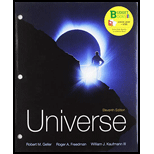
Concept explainers
(a)
The age of the universe for a Hubble constant of
(a)
Answer to Problem 21Q
Solution:
20 billion years.
Explanation of Solution
Given data:
The Hubble constant is
Formula used:
The relation between the age of the universe and the Hubble constant is given by the following expression,
Here,
Explanation:
Recall the relation between the age of the universe and the Hubble constant.
Substitute
Upon further solving,
Conclusion:
Therefore, the age of the universe is 20 billion years.
(b)
The age of the universe for a Hubble constant of
(b)
Answer to Problem 21Q
Solution:
13 billion years.
Explanation of Solution
Given data:
The Hubble constant is
Formula used:
The relation between the age of the universe and the Hubble constant is given by the following expression,
Here,
Explanation:
Recall the relation between the age of the universe and the Hubble constant.
Substitute
Upon further solving,
Conclusion:
Therefore, the age of the universe is 13 billion years.
(c)
The age of the universe for a Hubble constant of
(c)
Answer to Problem 21Q
Solution:
10 billion years.
Explanation of Solution
Given data:
The Hubble constant is
Formula used:
The relation between the age of the universe and the Hubble constant is given by the following expression,
Here,
Explanation:
Recall the relation between the age of the universe and the Hubble constant.
Substitute
Upon further solving,
From the calculation in all the three parts, the value of
Conclusion:
Therefore, the universe must be older than the oldest stars of the globular cluster. So, the Hubble constant should be such that the age of the universe is older than that of the oldest star in the globular cluster.
Want to see more full solutions like this?
Chapter 25 Solutions
Universe - Text Only (Looseleaf)
- According to Hubble’s law, what is the recessional velocity of a galaxy that is 108 light-years away from us? (Assume a Hubble constant of 22 km/s per million light-years.)arrow_forwardIf the diameter of the Milky Way Galaxys visible disk, 80,000 ly, is represented in a model by a dinner plate with a diameter of 10 inches, what is the model distance to galaxy M31, 2.6 millionly away? What is the model distance to the Virgo galaxy cluster, 16 Mpc away? (Convert answers to feet.)arrow_forwardWe have said that the Galaxy rotates differentially; that is, stars in the inner parts complete a full 360° orbit around the center of the Galaxy more rapidly than stars farther out. Use Kepler’s third law and the mass we derived in Exercise 25.19 to calculate the period of a star that is only 5000 light-years from the center. Now do the same calculation for a globular cluster at a distance of 50,000 light-years. Suppose the Sun, this star, and the globular cluster all fall on a straight line through the center of the Galaxy. Where will they be relative to each other after the Sun completes one full journey around the center of the Galaxy? (Assume that all the mass in the Galaxy is concentrated at its center.)arrow_forward
- What evidence can you give that we live in a galaxy?arrow_forwardSuppose that stars evolved without losing mass-that once matter was incorporated into a star, it remained there forever. How would the appearance of the Galaxy be different from what it is now? Would there be population I and population II stars? What other differences would there be?arrow_forwardWhat are the advantages and disadvantages of using quasars to probe the early history of the universe?arrow_forward
- Suppose the Sagittarius dwarf galaxy merges completely with the Milky Way and adds 150,000 stars to it. Estimate the percentage change in the mass of the Milky Way. Will this be enough mass to affect the orbit of the Sun around the galactic center? Assume that all of the Sagittarius galaxy’s stars end up in the nuclear bulge of the Milky Way Galaxy and explain your answer.arrow_forwardSuppose we could measure the distance to a galaxy using one of the distance techniques listed in Table 26.2 and it turns out to be 200 million light-years. The galaxy’s redshift tells us its recessional velocity is 5000 km/s. What is the Hubble constant?arrow_forwardAssume that the average galaxy contains 1011MSunand that the average distance between galaxies is 10 million light-years. Calculate the average density of matter (mass per unit volume) in galaxies. What fraction is this of the critical density we calculated in the chapter?arrow_forward
- What are the two best ways to measure the distance to a distant, isolated spiral galaxy, and how would it be measured?arrow_forwardSuppose somebody proposed that rather than invoking dark matter to explain the increased orbital velocities of stars beyond the Sun’s orbit, the problem could be solved by assuming that the Milky Way’s central black hole was much more massive. Does simply increasing the assumed mass of the Milky Way’s central supermassive black hole correctly resolve the issue of unexpectedly high orbital velocities in the Galaxy? Why or why not?arrow_forwardWhat Hubble constant corresponds to an approximate age of the universe of 1010 y? To get an approximate value, assume the expansion rate is constant and calculate the speed at which two galaxies must move apart to be separated by 1 Mly (present average galactic separation) in a time of 1010 yarrow_forward
 AstronomyPhysicsISBN:9781938168284Author:Andrew Fraknoi; David Morrison; Sidney C. WolffPublisher:OpenStax
AstronomyPhysicsISBN:9781938168284Author:Andrew Fraknoi; David Morrison; Sidney C. WolffPublisher:OpenStax Stars and Galaxies (MindTap Course List)PhysicsISBN:9781337399944Author:Michael A. SeedsPublisher:Cengage Learning
Stars and Galaxies (MindTap Course List)PhysicsISBN:9781337399944Author:Michael A. SeedsPublisher:Cengage Learning Foundations of Astronomy (MindTap Course List)PhysicsISBN:9781337399920Author:Michael A. Seeds, Dana BackmanPublisher:Cengage Learning
Foundations of Astronomy (MindTap Course List)PhysicsISBN:9781337399920Author:Michael A. Seeds, Dana BackmanPublisher:Cengage Learning


